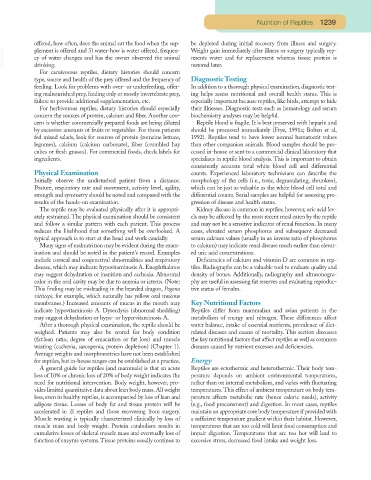Page 1189 - Small Animal Clinical Nutrition 5th Edition
P. 1189
Nutrition of Reptiles 1239
offered, how often, does the animal eat the food when the sup- be depleted during initial recovery from illness and surgery.
VetBooks.ir plement is offered and 3) water-how is water offered, frequen- Weight gain immediately after illness or surgery typically rep-
resents water and fat replacement whereas tissue protein is
cy of water changes and has the owner observed the animal
restored later.
drinking.
For carnivorous reptiles, dietary histories should concern
type, source and health of the prey offered and the frequency of Diagnostic Testing
feeding. Look for problems with over- or underfeeding, offer- In addition to a thorough physical examination, diagnostic test-
ing malnourished prey, feeding only or mostly invertebrate prey, ing helps assess nutritional and overall health status. This is
failure to provide additional supplementation, etc. especially important because reptiles, like birds, attempt to hide
For herbivorous reptiles, dietary histories should especially their illnesses. Diagnostic tests such as hematology and serum
concern the sources of protein, calcium and fiber. Another con- biochemistry analyses may be helpful.
cern is whether commercially prepared foods are being diluted Reptile blood is fragile. It is best preserved with heparin and
by excessive amounts of fruits or vegetables. For those patients should be processed immediately (Frye, 1991a; Bolten et al,
fed mixed salads, look for sources of protein (romaine lettuce, 1992). Reptiles tend to have lower normal hematocrit values
legumes), calcium (calcium carbonate), fiber (crumbled hay than other companion animals. Blood samples should be pro-
cubes or fresh grasses). For commercial foods, check labels for cessed in-house or sent to a commercial clinical laboratory that
ingredients. specializes in reptile blood analysis. This is important to obtain
consistently accurate total white blood cell and differential
Physical Examination counts. Experienced laboratory technicians can describe the
Initially observe the undisturbed patient from a distance. morphology of the cells (i.e., toxic, degranulating, shrunken),
Posture, respiratory rate and movement, activity level, agility, which can be just as valuable as the white blood cell total and
strength and symmetry should be noted and compared with the differential counts. Serial samples are helpful for assessing pro-
results of the hands-on examination. gression of disease and health status.
The reptile may be evaluated physically after it is appropri- Kidney disease is common in reptiles; however, uric acid lev-
ately restrained.The physical examination should be consistent els may be affected by the most recent meal eaten by the reptile
and follow a similar pattern with each patient. This process and may not be a sensitive indicator of renal function. In many
reduces the likelihood that something will be overlooked. A cases, elevated serum phosphorus and subsequent decreased
typical approach is to start at the head and work caudally. serum calcium values (usually in an inverse ratio of phosphorus
Many signs of malnutrition may be evident during the exam- to calcium) may indicate renal disease much earlier than elevat-
ination and should be noted in the patient’s record. Examples ed uric acid concentrations.
include corneal and conjunctival abnormalities and respiratory Deficiencies of calcium and vitamin D are common in rep-
disease, which may indicate hypovitaminosis A. Enophthalmos tiles. Radiographs can be a valuable tool to evaluate quality and
may suggest dehydration or inanition and cachexia. Abnormal density of bones. Additionally, radiography and ultrasonogra-
color in the oral cavity may be due to anemia or icterus. (Note: phy are useful in assessing fat reserves and evaluating reproduc-
This finding may be misleading in the bearded dragon, Pogona tive status of females.
vitticeps, for example, which naturally has yellow oral mucous
membranes.) Increased amounts of mucus in the mouth may Key Nutritional Factors
indicate hypovitaminosis A. Dysecdysis (abnormal shedding) Reptiles differ from mammalian and avian patients in the
may suggest dehydration or hypo- or hypervitaminosis A. metabolism of energy and nitrogen. These differences affect
After a thorough physical examination, the reptile should be water balance, intake of essential nutrients, prevalence of diet-
weighed. Patients may also be scored for body condition related diseases and causes of mortality. This section discusses
(fat:lean ratio, degree of emaciation or fat loss) and muscle the key nutritional factors that affect reptiles as well as common
wasting (cachexia, sarcopenia, protein depletion) (Chapter 1). diseases caused by nutrient excesses and deficiencies.
Average weights and morphometrics have not been established
for reptiles, but in-house ranges can be established at a practice. Energy
A general guide for reptiles (and mammals) is that an acute Reptiles are ectothermic and heterothermic. Their body tem-
loss of 10% or chronic loss of 20% of body weight indicates the perature depends on ambient environmental temperatures,
need for nutritional intervention. Body weight, however, pro- rather than on internal metabolism, and varies with fluctuating
vides limited quantitative data about lean body mass.All weight temperatures.This effect of ambient temperature on body tem-
loss, even in healthy reptiles, is accompanied by loss of lean and perature affects metabolic rate (hence caloric needs), activity
adipose tissue. Losses of body fat and tissue protein will be (e.g., food procurement) and digestion. In most cases, reptiles
accelerated in ill reptiles and those recovering from surgery. maintain an appropriate core body temperature if provided with
Muscle wasting is typically characterized clinically by loss of a sufficient temperature gradient within their habitat. However,
muscle mass and body weight. Protein catabolism results in temperatures that are too cold will limit food consumption and
cumulative losses of skeletal muscle mass and eventually loss of impair digestion. Temperatures that are too hot will lead to
function of enzyme systems.Tissue proteins usually continue to excessive stress, decreased food intake and weight loss.

